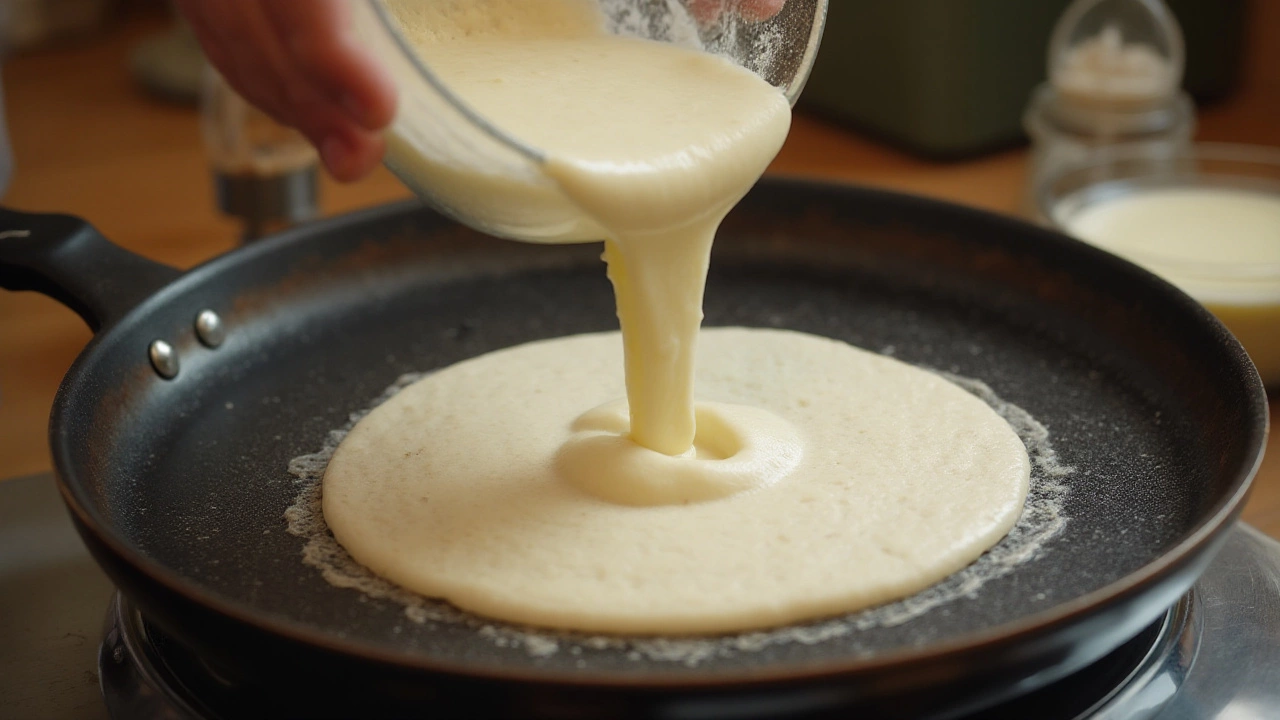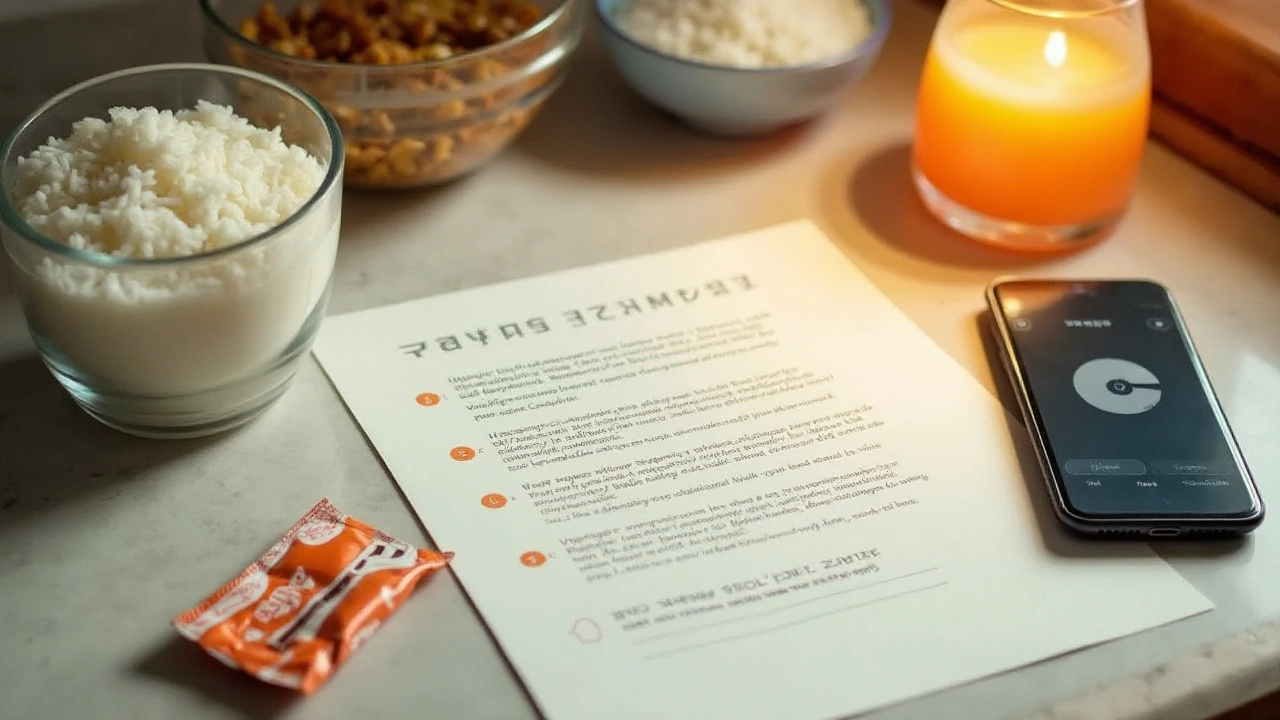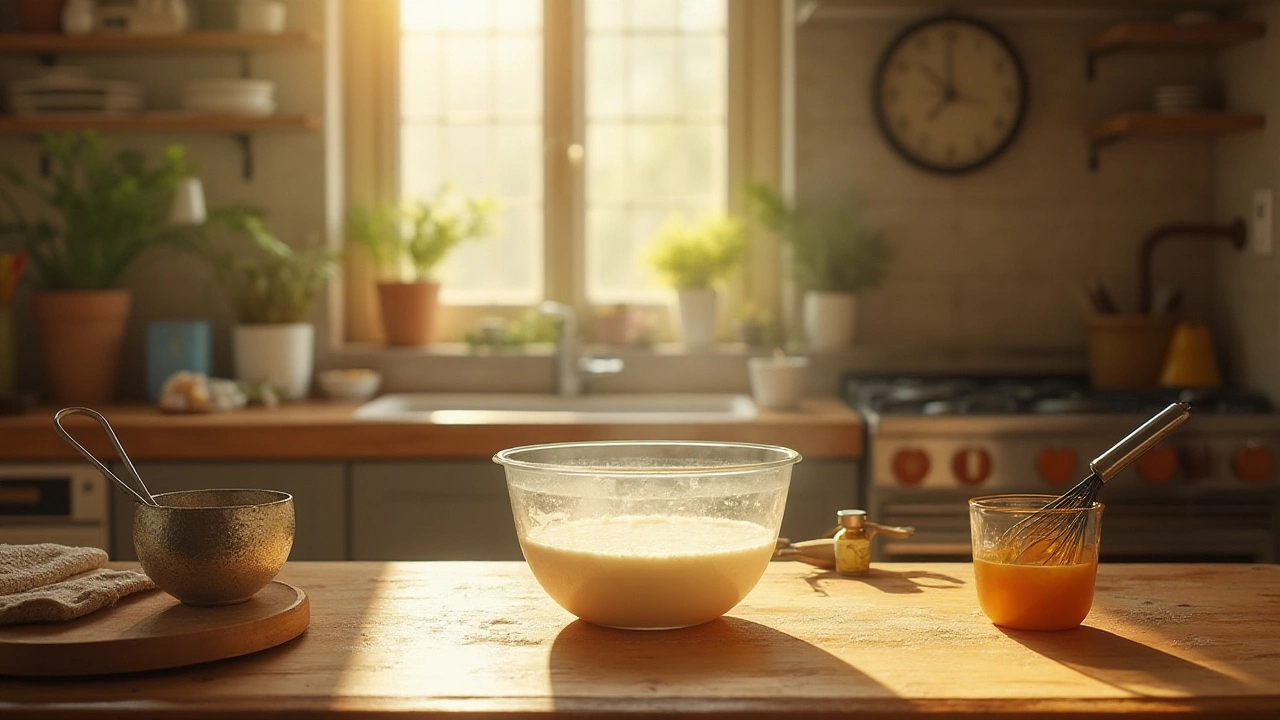Dosas, a beloved South Indian delicacy, have captured hearts worldwide with their crispy edges and soft centers. The secret behind these delicious pancakes lies in the perfectly fermented batter, traditionally requiring a wait of several hours. Yet, in our fast-paced world, time can often be a luxury.
For those eager to relish their favorite breakfast without the long wait, quick fermentation techniques promise a speedy and satisfying solution. This guide will walk you through the essential steps to achieving perfectly fermented dosa batter in record time. Delve into the science of fermentation, conquer temperature challenges, and discover simple kitchen hacks that transform your dosa-making experience.
- Understanding Dosa Batter Basics
- Role of Ingredients in Fermentation
- Temperature and Its Effects
- Using Instant Yeast
- Utilizing Kitchen Hacks
- Final Tips for Perfect Dosas
Understanding Dosa Batter Basics
Crafting the perfect dosa batter is an art that combines tradition with a sprinkle of science. At its core, a good dosa batter is a simple mix of rice and urad dal, often enriched with a touch of fenugreek seeds. These ingredients, although humble, play a pivotal role in the fermentation process. Rice provides the starch which serves as the primary nutrient for the fermentation, while urad dal, a type of lentil, is rich in protein, boosting the strength and elasticity of the batter. Fenugreek seeds, though added in small quantities, serve as a natural coolant and provide a characteristic aroma to the final dish.
The balance between rice and urad dal varies from family to family, often handed down through generations, each with its own little secret. However, the most commonly followed ratio is 3:1, meaning three parts rice to one part urad dal. The choice of rice can greatly affect the outcome, with short-grain idli rice favored for creating batter with the right consistency. Long-grain rice, while also used, may not yield the same fluffy and airy texture necessary for crispy dosa.
The Magic of Fermentation
Fermentation is a magical process where wild yeast and lactic acid bacteria convert sugars into acids, alcohol, and gases. This gives dosa its distinctive tangy flavor and airy texture. The process is influenced by a variety of factors including temperature, humidity, and even altitude, demanding patience and attention. In a warm kitchen, higher temperatures speed up fermentation, meaning the batter requires less time to rise. Alternatively, cooler climates slow this process, extending the waiting time. A consistent warmth is ideal, often achieved by placing the bowl in an oven with the light on or near a warm stovetop.
"A perfectly fermented batter sounds a gentle hiss when stirred, resembling the fizz of a freshly opened soda," notes Chef Venkatesh Bhat, a renowned culinary expert. "It's a sign that the gases have done their work."
Factors Influencing Fermentation
The success of the batter doesn’t just rely on ingredient proportions and environmental factors but also on the quality of water used in the soaking and grinding process. It's recommended to use filtered or bottled water, especially in areas with hard water, to ensure consistent results. The grind's finesse is another crucial aspect; a smooth, thick batter will hold on to the bubbles produced during fermentation, guaranteeing that desired spongy fluffiness when poured onto the hot griddle. Investing time in blending the rice and urad dal to a creamy consistency cannot be understated in importance.
In understanding these fundamentals, one appreciates that dosa batter is more than just a mix of components; it’s a testament to cultural nuance and precise skill. Whether you're replicating the traditional process or opting for instant methods using techniques like adding instant yeast, getting these basics right lays the foundation for delicious results. With a few tricks up their sleeve, even a novice can master the art of dosa-making, keeping alive a cherished tradition while catering to the demands of modern life.
Role of Ingredients in Fermentation
Creating the perfect dosa batter begins with choosing the right ingredients and understanding their specific roles in the fermentation process. Traditionally, dosa batter is made from a blend of rice and urad dal, also known as black gram. These core components, when soaked and ground together, provide the perfect groundwork for fermentation. While the rice contributes to the batter's body and structure, urad dal is responsible for generating the fluffy texture due to its high protein and amino acid content. The natural sugars in these ingredients, especially in the rice, are crucial as they feed the beneficial bacteria during fermentation.
The choice of rice can significantly influence the flavor and texture of dosas. Some prefer parboiled rice for its sticky nature, which enhances the batter's consistency. Others might opt for raw white rice to achieve a crispier outcome. Regardless of preference, it's essential to maintain the right ratio of rice to urad dal, which traditionally stands at about 3:1, ensuring proper fermentation. The presence of methi seeds (fenugreek) is another genius inclusion, often added in a sprinkling amount, as these seeds not only aid in fermentation by introducing additional natural sugars but also impart a slight tanginess to the batter.
According to renowned chef Madhur Jaffrey, "The success of dosa fermentation lies in a delicate balance of warmth, timing, and the quality of ingredients used."
Water is another significant factor and not just a medium to facilitate the grinding of rice and dal. The quantity and temperature of water can influence the batter's texture and fermentation rate. Lukewarm water, for instance, speeds up the fermentation process as it provides an optimal environment for the bacterial growth that's necessary for dosa batter. However, care must be taken not to make the batter too thick or too runny. The consistency should be free-flowing enough to pour out seamlessly onto a hot pan.
Salt, added after the initial hours of fermentation, acts not only as a flavor enhancer but ensures that the beneficial bacteria have the perfect environment to thrive without being overwhelmed by naturally occurring yeasts. It is a common practice to blend in salt after a few hours of initial fermentation, giving the batter time to begin its natural process before adding salt to taste. The inclusion of salt earlier can sometimes inhibit yeast and bacterial growth, resulting in a batter that doesn’t ferment as expected.
| Ingredient | Role |
|---|---|
| Rice | Provides texture and sugars |
| Urad Dal | Protein source for fluffiness |
| Methi Seeds | Natural sugar for tanginess |
| Water | Facilitates grinding and fermentation |
| Salt | Enhances flavor and bacterial growth |
For those pursuing rapid results, instant yeast might be used. This ingredient acts as a natural catalyst, assisting the fermentation process in less time. It’s crucial to understand that while yeast can aid in quickening the process, it may alter the traditional taste if overused, hence should be employed selectively. Understanding the harmony between these elements plays a pivotal role in achieving that perfect, flavorful, and fluffy dosa effortlessly.

Temperature and Its Effects
Temperature plays a pivotal role in the fermentation process of dosa batter, often dictating the speed and efficiency with which the batter ferments. Understanding this relationship is key for anyone looking to experiment with quicker methods of achieving the perfect dosa. Fermentation is a biological process that thrives in warmth, as the natural yeasts and bacteria in the environment work together to produce carbon dioxide and other byproducts that contribute to the batter's rise. During cooler months, or in generally cooler climates, the ambient temperature might not be sufficient to kickstart the fermenting agents in the dosa batter. In these cases, subtle adjustments can yield big differences. A simple trick is to preheat your oven to its lowest setting and then turn it off, creating a warm environment to store the batter overnight. However, be mindful of excessive heat which can spoil the batter or alter its taste.
Interestingly, different regions of the world have adapted unique solutions to combatless than ideal temperatures for fermentation. In New Zealand, where I reside, the cooler climate could hinder the swift fermentation of dosa batter. I have found wrapping the bowl in a thick towel and placing it in a sunny spot or near a heater can mimic the warm environments typical of South Indian kitchens. A comfortable room temperature ranging between 25°C to 30°C (77°F to 86°F) offers the best results, but adjusting to an indoor climate that's slightly warmer would surely act as a catalyst. As a fun fact, some chefs even introduce a slight variation by including minute quantities of mashed potatoes or cooked rice to the batter, ingredients known for elevating fermentation speed and enhancing the dosa's texture.
According to renowned chef and culinary scientist Harold McGee, "Fermentation is about guiding microbial processes so they create flavors and textures that we enjoy."But what happens if the batter gets too warm? Over-fermentation can turn the delightful tangy flavor of dosa into an unpleasant sourness, making it paramount to monitor both time and temperature when speeding up the process. Utilizing a thermometer to gauge the temperature can act as a fail-safe for those who want to ensure precision in their culinary endeavors. By tweaking these variables, one can master the art of balancing flavor, texture, and aroma efficiently, ensuring that your quick-tempo approach still yields dosas that are perfectly crispy on the outside and delectably soft on the inside.
Modern advances have provided cooks with even more options to facilitate quick and optimal fermentation. Instant fermentation can be further enhanced by gadgets like fermentation boxes or proofing boxes, designed specifically to maintain consistent temperatures conducive to fermentation. For those who find these tools inaccessible, there are simpler, cost-effective adjustments to consider. You could put your batter vessel atop a warmed towel or place it on a heating mat, similar to those used for seedlings, which gently provides the batter with consistent warmth.
Experimenting with these methods, whilst keeping note of your successes and adjustments, builds a rewarding path towards dosa expertise. Always remember that quick dosa fermentation isn't just a science; it's an art, one that allows for personal innovation and adaptations to your specific environmental conditions and culinary preferences.
Using Instant Yeast
In the realm of speedy dosa preparation, instant yeast emerges as a savior for those who wish to bypass the traditionally lengthy fermentation process of dosa batter. Thanks to its ability to rapidly activate sugars and kickstart the leavening process, instant yeast can significantly cut down on the waiting period while still preserving the authentic taste and texture of dosa. Its granules, finer than those of active dry yeast, dissolve readily, seamlessly integrating into the batter without the need for prior activation.
To harness the power of instant yeast, start with your usual mix of rice and urad dal, ensuring they are thoroughly soaked and ground to a smooth consistency. Once your base is ready, it's time to introduce the yeast. For every cup of rice used, add half a teaspoon of instant yeast to the batter. Stir it well, ensuring the yeast is evenly distributed throughout the mixture. This step is crucial for consistent fermentation. Next, place the bowl in a warm spot, covering it to create an optimal environment for yeast action.
Warmth is vital here, as it accelerates the yeast's activity. If your kitchen is chilly, a trick would be to place the bowl in an oven turned off, but with the light on; this minor heat source is typically enough to encourage rapid fermentation. Fascinatingly, this method doesn't just save time—it often results in a tangier batter, appealing to those who appreciate a pronounced sour note in their dosas.
If anybody thinks they can't enjoy a classic Indian dish amid modern schedules, they must try the yeast hack. This is the real taste of tradition in the future - Aditi Mehta, Culinary Instructor
Bear in mind, instant yeast is potent, and its effects can vary based on the temperature and the specific conditions of your kitchen. Some swear by adding a pinch of sugar to the mix to give the yeast an initial nudge, feeding it in this artificial ecosystem. Indeed, the addition of instant yeast cannot only hasten the process but, for some, it might enhance the depth of flavor, creating unique, aromatic results worthy of any breakfast table.
So why wait? Embracing instant yeast not only simplifies the production of quick dosa but also empowers home cooks to adjust flavor profiles according to personal taste preferences. As experimentation continues in home kitchens worldwide, instant yeast consistently proves itself a game-changer, blending seamlessly with ancient traditions to create modern culinary wonders.

Utilizing Kitchen Hacks
When time is of the essence and you crave a scrumptious dosa, understanding how to speed up the fermentation process can be your saving grace. Kitchens are full of gadgets and ingredients that, with a little creativity, can lend a hand in achieving that perfect, quick instant fermentation. One popular kitchen hack involves using rapid-rise or instant yeast, which can significantly cut down on fermentation time. By adding just a teaspoon of yeast to a cup of dosa batter, the fermentation process is enhanced, swiftly making it ready for cooking without compromising flavor or texture.
Another smart approach involves leveraging the inherent warmth of common appliances. Dosa batter needs a gentle warmth to ferment well, and placing the batter near a running appliance like the oven, or even inside with just the pilot light on, provides the perfect cozy environment. It helps if you cover the bowl with a damp cloth to preserve moisture. Some people extend their ingenuity further by repurposing their Instant Pots. By setting them on yogurt mode, you create a consistent warm setting that ferments the batter efficiently. It’s these little adjustments that make a big difference and save precious time.
Using fenugreek seeds in your batter can also serve a dual purpose. Not only do they enhance the fermenting process due to their natural enzymes, but they also add a hint of aroma and taste that beautifully complements the tanginess of quick dosa. Just soak a teaspoon of these seeds with your rice, and let their power work its magic. For yet another resourceful hack, a small amount of sugar can kickstart yeast activity, providing the necessary sugars for yeast to feed on, thus accelerating the carbonation process.
"The key to a good dosa lies in the lightness and texture of the batter, which is primarily achieved through adequate fermentation." – Chef Sneha Nimje, Culinary Expert
In essence, weaving these clever hacks into your dosa-making regime keeps things seamless without necessitating a complete overhaul of tradition. But remember, while hacks are great, they fall within the realm of experimentation — it's crucial to observe the changes they bring about in texture and taste. With patience and practice, mastering these tricks can make dosa recipe creation a delightful and spontaneous affair.
Final Tips for Perfect Dosas
Creating the perfect dosa is an art that can be enhanced with a few mindful practices. Once your dosa batter is fermented, consider this stage as the canvas upon which the masterpiece is to be crafted. Consistency is key; ensure that the batter is neither too thick nor too thin. The ideal consistency resembles that of a pancake batter—smooth and flowing, yet capable of holding shape when poured on a hot griddle. A ladle full of well-stirred batter should create a thin, uniform layer across the pan, achieving the classic dosa thinness that crisps up beautifully.
Heat control is another crucial factor. Preheat your dosa pan until a few drops of water sizzle and evaporate in seconds; this is the sweet spot for a golden, non-stick surface. It's advisable to have a consistent medium-high heat to maintain that uniform cooking. Too hot, and your dosa becomes a burnt, uneven mess; too low, and it turns soggy and fails to achieve that coveted crisp texture. Remember, maintaining consistent heat is easier when using a cast-iron or well-seasoned non-stick pan, the heavy base aids in distributing heat evenly.
Pouring and spreading the batter gracefully can make all the difference. Start from the center, using a circular motion to spread outwards with the back of your ladle, ensuring evenness. Avoid excessive force which can create tears, letting your ladle glide over the surface gently. If you're new to this practice, a little patience goes a long way, and a few initial scattered dosas will still taste delicious. To enhance your experience, drizzle a little oil or clarified butter around the edges once the batter has set; this helps lift the edges easily and adds flavor.
Serving is part of the dosa's charm; offer them hot and straight off the pan for the best experience. Accompany with a variety of chutneys, sambar, or spicy potato masala for an authentic experience. An insightful tip comes from renowned chef Madhur Jaffrey who says, "The secret to a good dosa lies just as much in the care taken in the smallest details as in the method itself."
Enjoying dosas isn't just about taste; it's the entire experience, including the aroma, the crackle, and the accompanying dips that make every bite a celebration.
Lastly, remember that practice makes perfect. The first few tries may not meet the perfection you envision, but every attempt is a step closer to that blissful bite. Experiment with the size and thickness that suits your palate the best, whether you prefer your dosas paper-thin and crisp or slightly thicker with a soft center. With these tips, you have the tools to make the perfect dosa a delightful reality.
